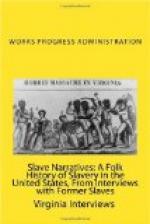“Boys jes’ wore shirts what looked lak dresses ’til dey wuz 12 years old and big enough to wuk in de field. Den dey put ’em on pants made open in de back. Dem britches would look awful funny now, but dey wuz all us had den, and all de boys wuz mighty proud when dey got big enough to wear pants and go to wuk in de fields wid grown folkses. When a boy got to be a man enough to wear pants, he drawed rations and quit eatin’ out of de trough.
“All de slave quarters wuz log cabins and little famblies had cabins wid jes’ one room. Old Marster sho’ did want to see lots of chilluns ’round de cabins and all de big famblies wuz ’lowed to live in two-room cabins. Beds for slaves wuz made by nailing frames, built out of oak or walnut planks to de sides of de cabins. Dey had two or three laigs to make ’em set right, and de mattresses wuz filled wid wheat straw. Dere warn’t no sto’-bought stoves den, and all our cookin’ wuz done in de fireplace. Pots wuz hung on iron cranes to bile and big pones of light bread wuz cooked in ovens on de hearth. Dat light bread and de biscuits made out of shorts wuz our Sunday bread and dey sho’ wuz good, wid our home-made butter. Us had good old corn bread for our evvyday bread, and dere ain’t nothin’ lak corn bread and buttermilk to make healthy Niggers. Dere wouldn’t be so many old sick Niggers now if dey et corn bread evvyday and let all dis wheat bread and sto’-bought, ready-made bread alone ’cept on Sunday.
“Dere wuz four or five acres in Marster’s big old gyarden, but den it tuk a big place to raise enough for all de slaves and white folkses too in de same gyarden. Dere wuz jus’ de one gyarden wid plenty of cabbage, collards, turnip greens, beans, corn, peas, onions, ‘taters, and jus’ evvything folkses laked in de way of gyarden sass. Marster never ’lowed but one smokehouse on his place. It wuz plumb full of meat, and evvy slave had his meat rations weighed out reg’lar. Dere wuz jes’ one dairy house too whar de slaves got all de milk and butter dey needed. Marster sho’ did b’lieve in seeing dat his Niggers had a plenty to eat.
“Marster raised lots of chickens and de slaves raised chickens too if dey wanted to. Marster let ’em have land to wuk for deyselves, but dey had to wuk it atter dey come out of his fields. All dey made on dis land wuz deir own to sell and do what dey wanted to wid. Lots of ’em plowed and hoed by moonlight to make deir own crops.
“Us used to hear tell of big sales of slaves, when sometimes mammies would be sold away off from deir chilluns. It wuz awful, and dey would jes’ cry and pray and beg to be ’lowed to stay together. Old Marster wouldn’t do nothin’ lak dat to us. He said it warn’t right for de chilluns to be tuk away from deir mammies. At dem sales dey would put a Nigger on de scales and weigh him, and den de biddin’ would start. If he wuz young and strong, de biddin’ would start ’round $150 and de highest bidder got de Nigger. A good young breedin’ ’oman brung $2,000 easy, ’cause all de Marsters wanted to see plenty of strong healthy chillun comin’ on all de time. Cyarpenters and bricklayers and blacksmiths brung fancy prices from $3,000 to $5,000 sometimes. A Nigger what warn’t no more’n jes’ a good field hand brung ’bout $200.




